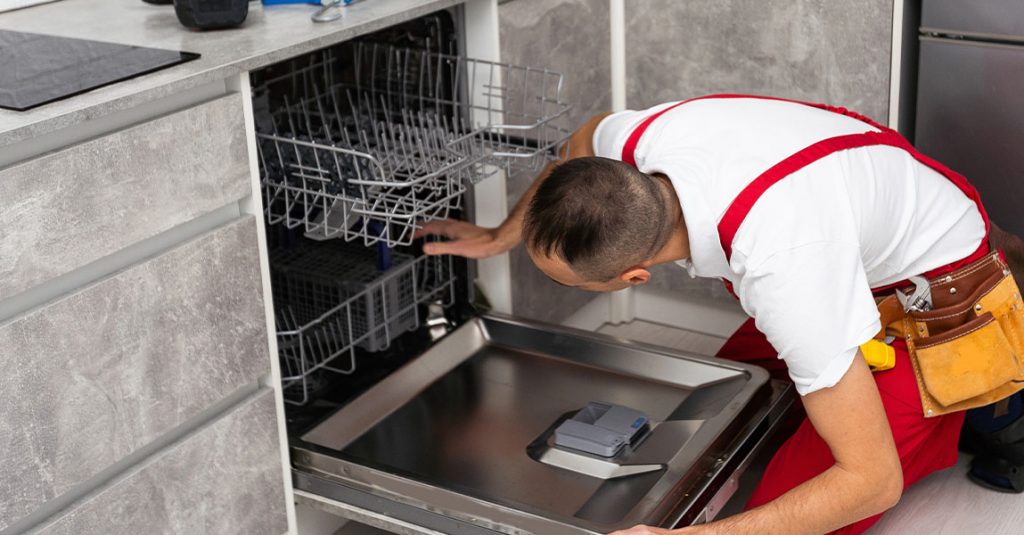When a dishwasher door will not latch, the entire cycle is put on hold. We depend on it to close securely so the machine can run safely and efficiently. In this guide, we will go through practical reasons why the door may not latch and what we can do to fix it. Our goal is to help you solve the problem step by step without confusion.
Understanding How the Latch Works
Every dishwasher door has a latch system that connects the door to the frame. This latch signals the control board that the door is securely shut. Without this signal, the dishwasher will not start. The latch also keeps water from leaking during cycles. Therefore, a faulty latch can affect both safety and performance.
We can compare it to a car seatbelt buckle. If it clicks properly, the system engages. If not, the safety feature is useless. That is why recognizing latch problems quickly is important. If ignored, even a small latch issue may lead to bigger complications.
Checking for Simple Obstructions
Sometimes the latch does not engage because something is blocking it. A fork handle, a large pan, or even a piece of debris stuck in the door groove can stop the latch from clicking into place. That is to say, not every latch problem comes from a mechanical failure.
We should always look at the racks and the door seals first. In other words, clearing away items that interfere may be enough to solve the issue. This is the simplest fix and should be the first step before moving to deeper troubleshooting.
Inspecting the Door Strike
The door strike is the metal piece that fits into the latch mechanism. If it bends or loosens, the latch cannot hold the door tight. Consequently, the dishwasher may stop mid-cycle or fail to start at all.
To check this, we can gently close the door and watch if the strike lines up with the latch. If it is off-center, tightening the screws or adjusting the alignment often solves the issue. This step requires no special tools other than a screwdriver.
Examining the Latch Assembly
If the strike is fine, then the latch assembly itself may be damaged. The latch contains springs and plastic parts that wear over time. When these parts lose tension, the door will not stay closed.
We can press the latch by hand when the dishwasher is open. If it feels loose or does not snap back, replacement is usually required. Most latches are sold as a single assembly, which makes installation straightforward. In this case, calling dishwasher repair Vancouver may be the best option if we are not comfortable handling electrical parts.
Looking at the Door Hinges
Hinges support the entire door weight. If they bend, the door may not line up with the frame properly, even if the latch is good. As a result, the door will fail to click shut.
We can test hinge strength by gently lifting the door when it is open halfway. Excessive wobbling means the hinges are worn. Replacing hinges requires more effort since the door must be detached, but it restores proper alignment and ensures the latch can work correctly.
Testing the Door Gasket
The gasket is the rubber seal around the dishwasher door. Over time, it hardens or warps, which can push the door away from the frame. This extra resistance makes the latch struggle to engage.
To clarify, the gasket does not need to look completely broken to cause problems. Even small waves or hardened spots can block the door from closing tightly. Replacing the gasket is a simple but effective solution that improves both latching and leak prevention.
Control Board Recognition Problems
Even when the latch works physically, the dishwasher control board may fail to register it. This happens when the switch inside the latch assembly is faulty. In such cases, the door may close fully but the machine still refuses to start.
Testing continuity with a multimeter confirms if the latch switch is sending signals. If no signal is detected, we will need to replace the latch assembly. At this stage, getting professional appliance repair services Vancouver is the safest choice, especially when electrical troubleshooting is involved.
Preventive Maintenance to Avoid Latch Failure
Regular care can help us avoid latch issues in the first place. Wiping the gasket, keeping food debris out of the latch slot, and loading dishes properly reduces stress on the system. Similarly, avoiding slamming the door helps prevent wear on both latch and hinges.
Above all, small habits like cleaning the latch area once a month go a long way in preventing breakdowns. This is a simple step that takes only a few minutes but adds years to the lifespan of the latch mechanism.
When to Call for Help
If we have checked obstructions, strike alignment, gasket condition, and latch movement but the dishwasher still will not latch, it is time to seek professional service. Door lock issues can sometimes point to deeper electrical or alignment problems that go beyond simple fixes.
When repairs are needed, we can easily contact us for an appointment. Our team is ready to troubleshoot thoroughly and bring the machine back to reliable working order.
FAQs
Why does my dishwasher door pop open during a cycle
This usually means the latch is weak or the strike is loose. Water pressure and vibrations push the door open when it is not fully secured.
Can I run the dishwasher if the latch is broken
No, the cycle will not start because the machine must confirm the door is shut. Forcing it closed can cause leaks and further damage.
How often should I replace the gasket
Most gaskets last five to seven years. If the door feels harder to close or small leaks appear, it may be time to replace it.
What tools do I need to replace the latch
A basic screwdriver is often enough. In some models, you may also need pliers to disconnect wires from the latch switch.
Is it worth repairing an old dishwasher with latch problems
If the dishwasher is more than ten years old, consider the overall condition. If other parts are also failing, replacing the unit might be more cost effective than constant repairs.

